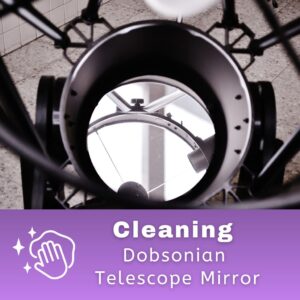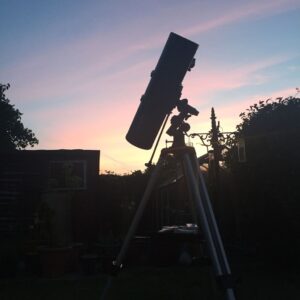This site contains affiliate links to products. I may receive a commission for purchases made through these links.
If you’re just dipping your toes into the vast ocean of stargazing, a Dobsonian telescope could be your perfect first mate. It’s simple, powerful, and perfect for beginners. With its user-friendly design and impressive light-gathering capabilities, it’s no wonder Dobsonians have become a favorite among amateur astronomers.
But what makes a Dobsonian telescope stand out from the crowd? It’s the unique combination of ease-of-use and high performance. The design is simple, making it easy to set up and start stargazing. Plus, these telescopes offer excellent views of distant galaxies, nebulae, and other celestial bodies. So, if you’re a beginner looking to explore the night sky, a Dobsonian telescope could be your ticket to the stars.
What is a Dobsonian telescope?
A Dobsonian telescope is a type of reflector telescope with a simple mount and a large aperture. Originally designed by John Dobson, the intention was to create a low-cost, effective tool for sky-watching. Today, these telescopes are among the popular favorites, transfixing stargazers worldwide with their ease accessibility and accuracy.
Named after its creator, the Dobsonian design’s hallmark characteristic is the alt-azimuth mount. This design simplifies the tracking of celestial objects. Dobsonian telescopes achieve easy movement in all directions making it user-friendly and perfect for beginners. Dobsonian telescopes let you navigate the night sky with ease and grace.
But Dobsonian scopes aren’t just about easy use! Their large aperture offers excellent views of distant galaxies, nebulae, and other celestial bodies. With their ability to gather more light compared to other types of telescopes, Dobsonian devices deliver brighter and clearer images. This feature sets it favorably apart in the world of stargazing.
Often, Dobsonian scopes are referred to as “Light Buckets”. This name gives a nod to their impressive ability to collect and concentrate light. When it comes to viewing the deep sky objects, the light-gathering capacity of the telescope matters. Therefore, it’s the Dobsonian’s superb capacity for this that solidifies its role as an ideal beginner’s telescope.
While their bulkiness can be challenging for portability, experts often find this trade-off well worth the superior viewing experience. Yet, its design remains simple, meaning even the least mechanically inclined can set up and start stargazing in no time. Beastly in performance yet elegant in simplicity — that’s the allure of a Dobsonian telescope.
The next section will delve deeper into why the Dobsonian telescope has become the beginner’s first choice in stargazing.
Why is a Dobsonian a great choice for beginners?
As an experienced star-gazer, I can tell you, there’s nothing quite like the thrill of observing the galaxies, nebulae, and star clusters through your own telescope. And for beginners just beginning their astrological journey, the Dobsonian telescope is a standout choice.
You might ask, Why is a Dobsonian a great choice for beginners? The answer is simple – for its ease of use, fantastic viewing quality, and affordability.
Most first-time telescope users are thrilled by the idea of seeing celestial wonders but are often intimidated by the complexities of some telescopes. Dobsonian telescopes, often referred to as ‘Light Buckets’ are notoriously user-friendly and stripped of these complexities. The simplistic mount allows for easy navigation while the large aperture ensures you get to enjoy the most amazing views of the night sky.
What makes Dobsonian telescopes really shine is their unprecedented power to gather light. These bad boys can collect and concentrate more light than many pricier telescopes due to their impressive aperture-to-cost ratio. Larger images of distant galaxies and celestial bodies? Check!
Talking about cost, these certain Light Buckets won’t break your bank. They are typically more affordable compared to other types of telescopes with the same aperture. This makes them an excellent budget-friendly choice for beginner astronomers who don’t want to compromise on their viewing experience.
And let’s not forget the quick set-up time. Unlike some high-tech scopes, you don’t need to spend hours assembling your Dobsonian telescope, nor do you need to understand software or motor-driven mounts.
Understanding the design of a Dobsonian telescope
When it comes to understanding the design of a Dobsonian telescope, there are a few key points to keep in mind. First off, its defining feature is its rather simplified but effective alt-azimuth mount. With horizontal and vertical movements, it allows for easy manual tracking of celestial objects, making it incredibly user-friendly for beginner stargazers.
But don’t think the telescope’s simplicity restricts its performance. In fact, it’s quite the opposite. The Dobsonian design incorporates a large aperture, which is a primary factor in enhancing image quality. The larger the aperture, the more light the telescope absorbs. This unique feature makes the Dobsonian a powerhouse when it comes to stargazing, providing an exceptional view of the night sky.
While we’re on the subject of light, let’s not forget the Dobsonian telescope’s ability to gather and concentrate it. This capability, combined with the large aperture, allows you to see further and more clearly, offering larger-than-life images of galaxies and celestial bodies. For beginners, this is quite the treat.
Additionally, the Dobsonian is praised for its portability. With a compact and lightweight design, it’s easy to carry and set up anywhere you fancy a stargazing session. So, whether you’re camping in the wilderness or just enjoying the night sky from your backyard, a Dobsonian telescope is a handy companion.
The affordability of Dobsonian telescopes doesn’t compromise their quality. These telescopes offer users the same viewing capabilities as more expensive models. This is yet another reason why they’ve become so popular among beginners. So, for those getting into astronomy, Dobsonian telescopes open up a cost-effective gateway to explore the mysteries of the cosmos.
Before we delve deeper into the topic, it’s important to mention that Dobsonian telescopes do have their limitations. While they’re superb for deep-sky viewing, they may not be the best when it comes to planetary or lunar observation. This limitation is generally due to the lack of motorized tracking, which can make observing fast-moving objects a bit difficult. However, they still provide an excellent start for newcomers to the hobby of astronomy.
Setting up your Dobsonian telescope
As a beginner, I know setting up a new telescope can seem like a daunting task. However, one of the greatest benefits of the Dobsonian model is its simplicity of assembly. In this part, we’ll delve into the steps that will help you set up your Dobsonian telescope with ease.
First, I’ll mention the three primary components of your Dobsonian telescope: the tube, the base, and the finderscope. These may come separately packaged in the box but don’t be alarmed – you’re just a few simple steps away from having your telescope ready for night sky exploration.
Your first step is to place the base on a flat and stable platform. When you’re doing this, remember that the base’s purpose is to support the weight of the telescope tube with stability so it’s important to do this right. Portability and simplicity might be key attributes of the Dobsonian telescope, but it also needs the right environment to perform at its best.
Secondly, take your telescope tube and set it on top of the base. There would usually be screws to tighten and secure the tube onto the base. Make sure it’s well adjusted so the tube can maintain balance and rotate smoothly in all directions. The simplicity of its alt-azimuth mount means you can navigate your telescope easily by moving it up and down, left and right.
With that done, your telescope is near completion! The last thing you’ll want to do, although optional, is to attach your finderscope. This nifty tool aids in zeroing into smaller objects in the skies and spotting them much faster.
It’s also important to keep in mind that while Dobsonians are an excellent choice for quick and hassle-free setup, regular maintenance and proper handling are essential for their longevity and performance.
- Storage: Don’t leave your Dobsonian exposed to harsh weather or wet environments. Store it in a clean, dry place and cover it when not in use.
- Cleaning: Use an air blower or paintbrush to clean the optics and avoid touching the mirror. If necessary, use a soft cloth and optics cleaning solution.
Exploring the night sky with a Dobsonian telescope
Now that we’ve covered the basics of what a Dobsonian telescope is and how easy it is to set up, let’s dive deep into the experience of exploring the night sky with this user-friendly instrument.
With a Dobsonian telescope, you’re not just looking at the night sky – you’re becoming a part of the celestial exploration. Regardless of if you’re a beginner or an experienced stargazer, this telescope facilitates a one-of-a-kind journey through the cosmos.
Dobsonians are loved for their large aperture, which translates into crisp views of celestial bodies beyond our solar system. For example, nebulae (massive clouds of gas and dust in space) and galaxies far from our own become discernible. Even though these objects are notoriously dim, the high light-gathering capabilities of Dobsonian telescopes will allow you to gaze into the farthest corners of the universe.
What comes as a surprise to many first-time users is the detail with which you can observe the moon. The textured surface, filled with craters and mountain ranges, comes to life under the gaze of a Dobsonian. Contrary to what some might think, Dobsonian telescopes do provide worthwhile experiences for planetary observation as well.
Setting targets for your stargazing endeavors can be useful. Planets such as Jupiter, with its cloud bands and brilliant moons, or Saturn, with its spectacular ring system, are rewarding views for any stargazer. Do remember, though, that the lack of a motorized tracking system means you’ll need to manually adjust your telescope as these planets move across the night sky.
I should mention that the quality of your viewing experience can also depend on factors such as the weather and light pollution. It’s ideal to use your Dobsonian in a place with minimal artificial light and on clear, calm nights for the best views.
Finally, I leave you with this nugget of wisdom: while a Dobsonian telescope can take you on an incredible journey through the stars, it’s the curiosity and passion for learning that truly fuels the stargazer’s journey. The universe is a vast and infinite place, full of thousands of wonders waiting for your discovery.
Conclusion
So there you have it. Dobsonian telescopes are an excellent starting point for beginner stargazers. They’re easy to use, offer fantastic viewing quality, and won’t break the bank. With their user-friendly design and large aperture, you’ll be exploring distant galaxies in no time. While they may not be perfect for planetary viewing due to the lack of motorized tracking, the sheer joy of discovering nebulae, observing the moon’s surface, or spotting Jupiter and Saturn makes them worth considering. Remember, factors like weather and light pollution can affect your viewing experience, but don’t let that curb your curiosity or dampen your passion for learning. In the end, it’s all about the journey, not just the destination. So grab a Dobsonian telescope and start your astronomical adventure today.
Frequently Asked Questions
What are the benefits of using Dobsonian telescopes for beginners in stargazing?
Dobsonian telescopes are a beginner-friendly option due to their ease of use, high-quality viewing, and affordability. They have simple mounts, large apertures, and they deliver excellent celestial views, concentrating light to produce impressively large images of distant objects.
How user-friendly are Dobsonian telescopes?
These telescopes are stripped of complexities and feature simplistic mounts for easy navigation. This, along with their quick set-up time and no requirement for extensive assembly or understanding of software, makes them very user-friendly.
Are Dobsonian telescopes affordable?
Yes, Dobsonian telescopes are often more affordable than other telescopes with the same aperture. Despite their lower price, they offer the same viewing capabilities as more expensive models, making them a cost-effective choice.
Can Dobsonian telescopes be used for planetary or lunar observation?
While Dobsonian telescopes are great for deep sky viewing, they might not be the best for planetary or lunar observation due to the lack of motorized tracking.
What factors can affect the viewing experience with a Dobsonian telescope?
Factors such as weather conditions and light pollution can affect the viewing experience. Despite these factors, these telescopes enable the exploration of nebulae, galaxies, the Moon’s detailed surface, and even other planets.




